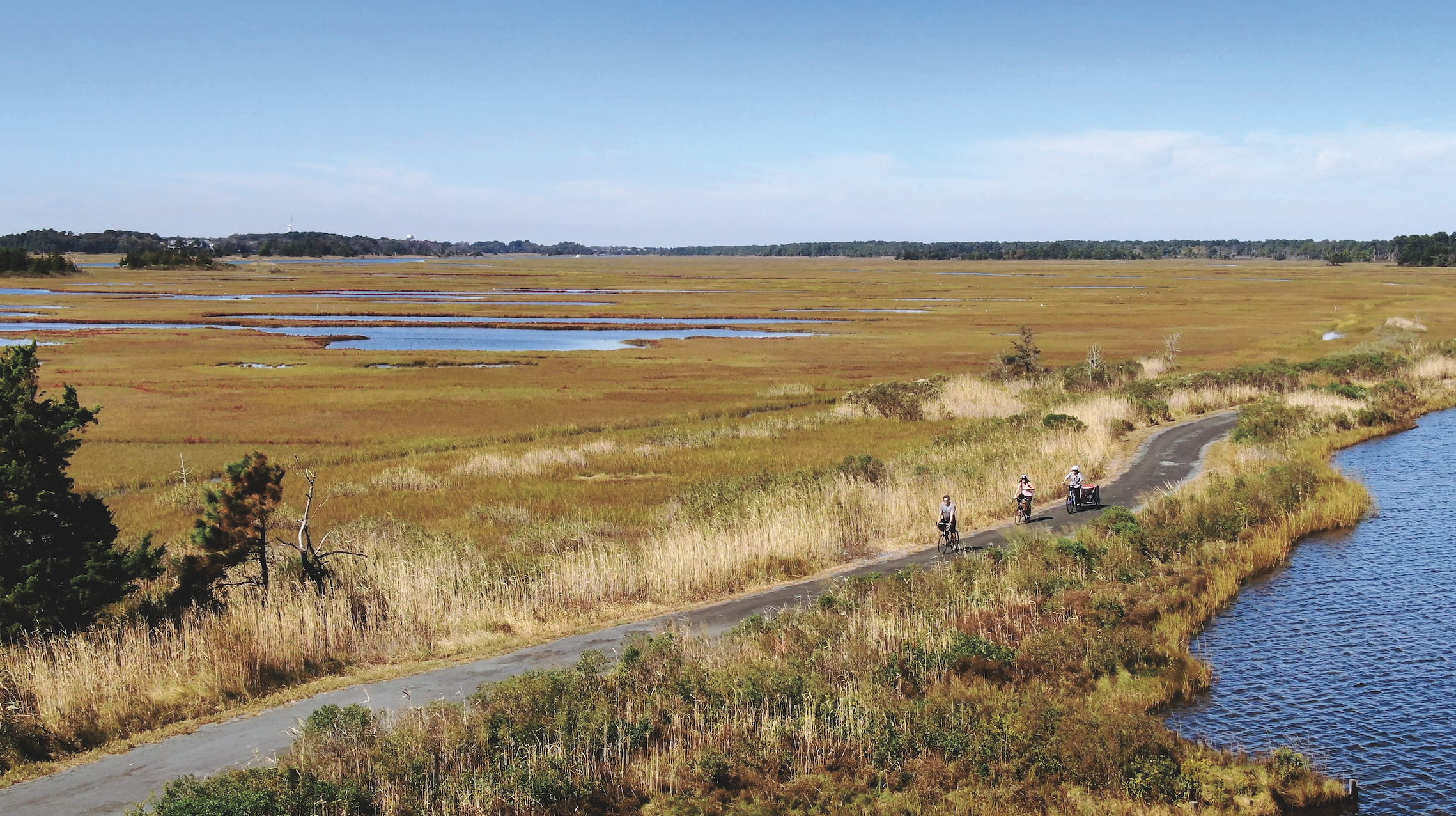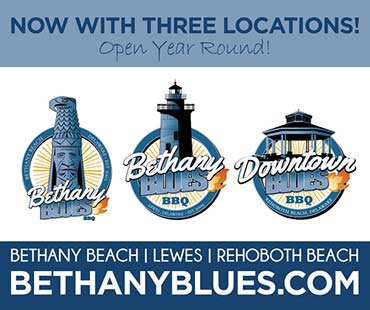
Local bike-or-hike paths connect coastal communities — and the like-minded folks drawn to them
By Jeanne Shook
Photograph by Rob Waters
From the June 2021 issue

If you ask Siri, “How do I get to Gordons Pond?” don’t be surprised if she replies, “You can’t get there from here.” Even Siri knows that some of coastal Delaware’s most scenic spots are not accessible unless the mode of transportation is bicycle or shoe leather express.
Biking the trails in coastal Delaware is akin to surfing in Southern California: a year-round activity so embraced by residents and visitors alike that it’s become an integral part of the Slower Lower ethos, earning the state national attention. The League of American Bicyclists currently ranks Delaware sixth in the country on its list of bicycle-friendly states. And Lewes has been singled out as a bronze-level “Bicycle Friendly Community,” the league’s designation for towns and municipalities that foster a culture of bicycling for everyone.
“Everyone,” it seems, was out in full force in 2020 as the trails were more heavily populated than ever, due to the coronavirus. As Bill Nesper, the league’s executive director, puts it, “During one of the toughest years in recent memory, we have seen so many Americans turn to biking during the pandemic as a necessary transportation option, as a vehicle for exercise, and as a way to find some joy on a bike.”
John Kurpjuweit, president of Sussex Cyclists, concurs: “We’ve noticed more people on the trails. ... Bike shops couldn’t keep bikes in stock.”
Perhaps nowhere is the local biking spirit more evident than on coastal Delaware’s trio of connecting trails. Gordons Pond, Junction & Breakwater and Lewes-Georgetown constitute a unique “transportation” network that continues to attract growing numbers of cyclists and pedestrians.
So whether you’re seeking recreation, inspiration or perspiration, hop on a bicycle, or lace up your athletic shoes and hit the trails. And as Yogi Berra once advised, “When you come to a fork in the road, take it.”
Gordons Pond Trail
Of the three trails, Gordons Pond leads the pack in popularity, providing up-close-and-personal proximity to the ocean, sand dunes, tidal pools and glimpses of their inhabitants. Cyclists, hikers, birdwatchers and nature lovers of all kinds converge along this trail to observe the flora and fauna — especially waterfowl — that change with the seasons.
Opened in 2014 to much fanfare, the Gordons Pond trail was created from a primitive path that had been used by the military based at Fort Miles. Prior to its completion as a full-length trail, an improved section extended about a half-mile from the Gordons Pond parking lot toward the pond, where it reached a dead-end. At its dedication, Kurpjuweit lauded the new trail as “a major enhancement in the outdoor recreational opportunities in this area. … Whether cycling, running or walking, trail users now have additional means to improve their health and fitness, or simply to enjoy the beauty of coastal Delaware.”
Nearly a half-mile of the 3.2-mile crushed-stone path is an elevated boardwalk with two observation lookouts. A centerpiece of the trail is a wildlife observation platform that offers unparalleled views of the ocean, Gordons Pond and historic World War II observation towers.
Depending upon the time of year, a pair of binoculars can enhance sightings of a variety of shorebirds and “waders,” including osprey, loons, ducks, herons, an occasional bald eagle, snowy owls in winter and — perhaps that rarest of birds — Marine One, the presidential helicopter. Milton-area resident and cycling enthusiast Kevin Lynam loves all the trails, but admits that Gordons Pond is his favorite, especially “the raised bike and walking paths and scenic views of wildlife.”
This meandering path has just two access points from opposite ends of Cape Henlopen State Park: Herring Point in the north and Gordons Pond parking lot at the Rehoboth end of the park — now also serving as President Biden’s helicopter pad.
Junction & Breakwater Trail
The oldest of the three byways and the longest rail-trail in Delaware, the Junction & Breakwater opened in 2003. Named after the 19th century rail line that connected Lewes and Rehoboth Beach, the trail’s diverse mix of woodlands, bucolic farmland, tidal creeks and coastal marshes is interspersed throughout 6 miles of a crushed stone and paved trail.
Serene wooded areas, with shade-providing tree canopies, are a welcome respite from the summer sun — and evolve into a breathtaking canvas of leaves as autumn arrives. One of the trail’s most picturesque spots is a restored 80-foot railroad bridge built in 1913. Overlooking Holland Glade’s salt marshes, the site is a popular stop for taking in the view (or for taking selfies).
Easy access to the trail at three locations adds to its popularity: from the Rehoboth Beach side, behind the Tanger Outlets Seaside Center, just off Holland Glade Road; from Wolfe Neck Road, about midway along the trail; and from the trailhead next to the Lewes Public Library.
Because the route connects Lewes and Rehoboth Beach, the J&B also offers an attractive alternative to Route 1’s summer traffic congestion between the two resort towns. “In the summer, if you were to hop in a car on Second Street in Lewes, and I was right next to you, I could probably bike to Rehoboth quicker than you could drive it,” Lynam says with confidence. And he should know. Lynam and his wife, Jackie, pedal along the trails regularly.
In January 2020, this 30-something couple co-founded Delaware Beach Bike Party, a network for those who share a “mutual love of biking and our great trail system in Sussex County.” The group is closing in on 1,400 members, all of whom welcome the opportunity to connect with like-minded adventurers seeking a sense of community and camaraderie.
At the end of every month, from March through November, the Lynams orchestrate group rides of 15 to 45 bicyclists throughout Cape Henlopen State Park and the other connecting trails. Jackie admires the beauty of the scenery, but also the trails’ maneuverability for even the most inexperienced bikers. “They also provide a safe travel alternative,” she says, noting that bikers can ride from the Cool Spring area all the way to Rehoboth and almost never ride on a road — something the Lynams prove on a weekly basis.
One day each week, they challenge themselves with a “no cars today” ritual, sometimes biking to dinner in Rehoboth and traveling home at dusk. The couple live just three-quarters of a mile from the Lewes-Georgetown trail, so cycling is second nature to them, providing a connection with neighboring towns, local businesses, eateries and friends along the way. (For more information about Delaware Beach Bike Party’s membership, monthly group rides and events, visit facebook@delawarebeachbikeparty.)
Lewes-Georgetown Trail
Where the J&B ends at the Gills Neck Road terminus in Lewes, the Lewes-Georgetown trail begins a 6-mile stretch to its present “end of the line”: where Route 9 meets Cool Spring Road. This newcomer to the trail trinity kicked into gear in 2016 with phase one and has been on the fast track of development and expansion ever since.
The trail’s paved asphalt surface makes it popular with cyclists, the occasional skateboard or rollerblading enthusiast, and walkers of all ages and sizes. Even kids on training wheels can conquer this byway. But caution is advised, since its smooth surface also makes it popular with bikers out to break their personal best speed records. (Golf carts, ATVs, and Segways are not permitted, though power-assisted e-bikes are allowed if the motor is less than 750 watts.)
Unlike its counterparts, this corridor features “wildlife” of the human variety. The former rail bed of the Delaware Coast Line Railroad cuts a swath through Lewes’s backyards, offering slice-of-life glimpses into the area’s hidden neighborhoods.
Ray and Geraldine Zweigle reside along the trail between Savannah and Old Orchard roads. The couple, who bike the trails often, observed that their portion of the thoroughfare was lacking points of interest. So they decided to create one. Wanting to give passersby “something that would bring a smile to their faces,” Ray has set up a bubble machine, an occasionally visiting space alien, and mannequins dressed in varied, often seasonal, attire. (Just beyond the Zweigles’ yard, two majestic horses while away the hours behind a split-rail fence, offering a contrasting scene of peace and tranquility.)
One of the major features of the Lewes-Georgetown trail is the ability to travel beneath Route 1 at Nassau Road. As cars and trucks whiz by overhead, trailgoers can recreate leisurely and safely, admiring (or maybe not) the plethora of lawn ornaments, pink flamingos, gazing balls and folk art on view. Nestled amid all these accoutrements of humanity are grazing dairy cows, some days close enough that onlookers can “talk to the animals” while taking a moment to hydrate.
The final phase of the trail’s expansion eventually will link Lewes to Georgetown, encompassing a total of 17 miles. A work in progress, this leg of the journey hinges on current discussions about a pedestrian/bicycle bridge that would allow safe passage across Route 9 at Cool Spring Road. The town of Milton is also on the radar as a future destination on the continuing rail-trail.
Regardless of the route you take, be prepared to encounter an assortment of bicyclists (even the recumbent kind), walkers, joggers, leashed dogs, and parents with strollers lured by the call of the wild, the beauty of the trails or the desire for exercise and a healthier lifestyle.
And no matter which direction you’re headed, let the great Yogi’s words of wisdom be your guide: “If you don’t know where you’re going, you’ll end up someplace else.” Where fresh air, serenity and nature abound — as on coastal Delaware’s trail network — there’s no such thing as a wrong turn.



